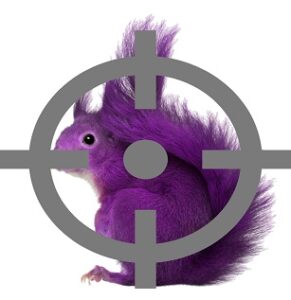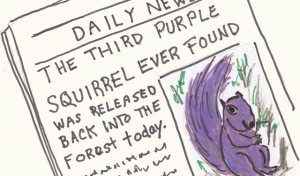 There’s a good reason why no one ever finds that elusive “purple squirrel” when they’re recruiting for a job.
There’s a good reason why no one ever finds that elusive “purple squirrel” when they’re recruiting for a job.
It’s because 999 times out of a thousand, they don’t exist.
Here’s the best definition of a “purple squirrel” I’ve seen. It comes from the good folks over at Urban Dictionary, and it seems to ring true:
For all practical purposes, there is no such thing as a “Purple Squirrel” — not in nature and not in the job market. It is a metaphor used by recruiters to identify the unrealistic expectations of a client company.
The happy exception is when a perfect candidate, with exactly the right qualifications and experience, is actually found for a job opening. That person would then be referred to as a “Purple Squirrel.”
But every human being is flawed, and even if the candidate has all the requirements, i.e. IS a Purple Squirrel, they might not even get a phone screening.
Thus, even one recruiter’s Purple Squirrel can be “just another disqualified candidate” to the client company. …”
Job postings that seem impossible for anyone to match
I bring this up because I recently got together with an old friend who works in the automotive industry, and we somehow got to talking about Edmunds.com. He mentioned that Edmunds had been looking for a new editor-in-chief for over a year, and when I expressed surprise at that, my friend said, “well, take a look at their job description. Nobody can possibly meet all the requirements. They’re looking for a unicorn or a purple squirrel.”
So, I went and looked at the Edmunds posting for their editor-in-chief job, and guess what? My friend is absolutely right.
Now, I know I could find some really good candidates for that job, and in fact, I know people who would be great for it. But my friend had the right analysis. Nobody could possibly meet ALL the requirements Edmunds is demanding.
When companies do this, it usually means one of two things:
- They don’t really want to fill the job but are advertising for it anyway in case a reasonably priced “purple squirrel” happens to come their way; or,
- They’re complete delusional and unrealistic in what is reasonably needed to be successful at the job.
 As someone who has worked a lot of places, and been recruited and hired on a couple of occasions through a search firm, I know that are always secondary skills that companies would like you to have that may not be listed on your own menu of skills and accomplishments.
As someone who has worked a lot of places, and been recruited and hired on a couple of occasions through a search firm, I know that are always secondary skills that companies would like you to have that may not be listed on your own menu of skills and accomplishments.
In my case, I usually managed to “step up” on the infrequent occasions when those were needed, and often when I did, I found I was better at them than I thought.
But that’s not we’re talking about here, and in case you think that this Edmunds job post is some sort of aberration, think again because I’m seeing posts like this from all sorts of companies when I get my weekly feed from LinkedIn.
Take a look at this one from Apple for a communications writer. Or, this one from Crackle for a Director of Integrated Content. Or The Outcast Agency job post for VP of Business Strategy. Or, even this one for an Editorial Manager at Pottery Barn Kids & Teens.
These are just a few I found but I’ve been seeing more and more job ads like this in the past few months. I wish we would have fewer of the ones that seem to be looking for Superman or Wonder Woman, or have a list of skills and competencies they want that are a mile long, and more like this one from Tesla listing some pretty reasonable requirements for a Communications Manager.
Purple squirrels and the search for perfection
Here’s my take: there are way too many companies/recruiters/talent managers who seem to be looking for the “perfect” candidate, or that elusive “purple squirrel,” when it’s clear that there are a number of good people applying who could successfully do the job. Sadly, and all too often, they get little real consideration when they apply.
In the futile hunt for perfection, they’re missing out on a lot of people who are pretty solid.
If anything, I think the hunt for the “purple squirrel” is worse today than back 2013 when my old friend and colleague Lance Haun wrote this for the Harvard Business Review:
Purple squirrels are the trophies of the talent acquisition world. Everyone has a story about how they almost gave up a search until something happened that changed their fortunes. Being a former recruiter myself, I’m pretty proud of my purple squirrel moments, too.
For every purple squirrel hire out there though, there are dozens, if not hundreds, of open, unfilled job openings. Look at the career pages of some of the largest companies. Some of the best places to work in the tech industry like Google and Microsoft have hundreds of job openings that have been there for four, five and six months or more. They aren’t the only ones by a long shot. Hiring managers and recruiters keep them open hoping that one day, they’ll get a notification of the perfect new applicant.
Too often, that candidate never materializes. If the purple squirrel doesn’t show, you’ve spent money and time on a fruitless endeavor. …
I’m not suggesting you go the other direction and hire whomever you want, no matter the consequence. It is time, however, to think much more strategically about purple squirrels and the pursuit of perfect candidates everywhere.”
A modern day snipe hunt
Lance is right. The “pursuit of perfect candidates everywhere” is nothing more than a modern day snipe hunt for both recruiters and candidates alike.
Yes, no one ever finds that elusive “purple squirrel” when they’re recruiting for a job because 999 times out of a thousand, they don’t exist.
Those odds may seem a whole lot better than this week’s PowerBall, but trust me, not by that much.
Authors
John Hollon
John Hollon is managing editor at Fuel50, an AI Opportunity Marketplace solution that delivers internal talent mobility and workforce reskilling. You can download the research reports in their Global Talent Mobility Best Practice Research series at Fuel50.
Recruit Smarter
Weekly news and industry insights delivered straight to your inbox.





